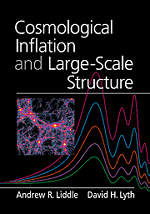Book contents
- Frontmatter
- Contents
- Frequently used symbols
- Preface
- 1 INTRODUCTION
- 2 THE HOT BIG BANG COSMOLOGY
- 3 INFLATION
- 4 SIMPLEST MODEL FOR THE ORIGIN OF STRUCTURE I
- 5 SIMPLEST MODEL FOR THE ORIGIN OF STRUCTURE II
- 6 EXTENSIONS TO THE SIMPLEST MODEL
- 7 SCALAR FIELDS AND THE VACUUM FLUCTUATION
- 8 BUILDING AND TESTING MODELS OF INFLATION
- 9 THE COSMIC MICROWAVE BACKGROUND
- 10 GALAXY MOTIONS AND CLUSTERING
- 11 THE QUASI-LINEAR REGIME
- 12 PUTTING OBSERVATIONS TOGETHER
- 13 OUTLOOK FOR THE FUTURE
- 14 ADVANCED TOPIC: COSMOLOGICAL PERTURBATION THEORY
- 15 ADVANCED TOPIC: DIFFUSION AND FREESTREAMING
- Appendix: Constants and parameters
- Numerical solutions and hints for selected examples
- References
- Index
9 - THE COSMIC MICROWAVE BACKGROUND
Published online by Cambridge University Press: 05 June 2012
- Frontmatter
- Contents
- Frequently used symbols
- Preface
- 1 INTRODUCTION
- 2 THE HOT BIG BANG COSMOLOGY
- 3 INFLATION
- 4 SIMPLEST MODEL FOR THE ORIGIN OF STRUCTURE I
- 5 SIMPLEST MODEL FOR THE ORIGIN OF STRUCTURE II
- 6 EXTENSIONS TO THE SIMPLEST MODEL
- 7 SCALAR FIELDS AND THE VACUUM FLUCTUATION
- 8 BUILDING AND TESTING MODELS OF INFLATION
- 9 THE COSMIC MICROWAVE BACKGROUND
- 10 GALAXY MOTIONS AND CLUSTERING
- 11 THE QUASI-LINEAR REGIME
- 12 PUTTING OBSERVATIONS TOGETHER
- 13 OUTLOOK FOR THE FUTURE
- 14 ADVANCED TOPIC: COSMOLOGICAL PERTURBATION THEORY
- 15 ADVANCED TOPIC: DIFFUSION AND FREESTREAMING
- Appendix: Constants and parameters
- Numerical solutions and hints for selected examples
- References
- Index
Summary
The remainder of the main body of the book concerns observations and the ways in which they can be used to constrain the theoretical development we have made so far. The level of technical detail will be considerably less, because the observational situation doubtless will change. Roughly speaking, we shall be working from the largest scales to the smallest, beginning here with the cosmic microwave background (cmb).
Large angles and the COBE satellite
When we study cmb anisotropies on large angular scales, we are as close as one can get to directly studying the initial perturbations. In Section 2.4, we found that the Hubble length at the time of last scattering subtends an angle of around 1 deg on the last-scattering surface itself. On scales significantly larger than this, we are directly studying the effects of perturbations on scales greater than the Hubble length at the time of decoupling, which therefore have retained their primordial form.
The crucial observations in this regime are those of the Cosmic Background Explorer (COBE) satellite, taken over four years, which rightly can be said to have revolutionized cosmology. These observations provided, for the first time, an estimate of the spectrum of inhomogeneities in the Universe on very large scales, of order thousands of megaparsecs.
The COBE satellite carried three separate experiments. The Far Infra-Red Absolute Spectrometer (FIRAS; Mather et al. 1990) provided what is by far the most accurate measurement of the frequency spectrum of the microwave background, confirming it as a blackbody within experimental limits.
- Type
- Chapter
- Information
- Cosmological Inflation and Large-Scale Structure , pp. 244 - 261Publisher: Cambridge University PressPrint publication year: 2000



